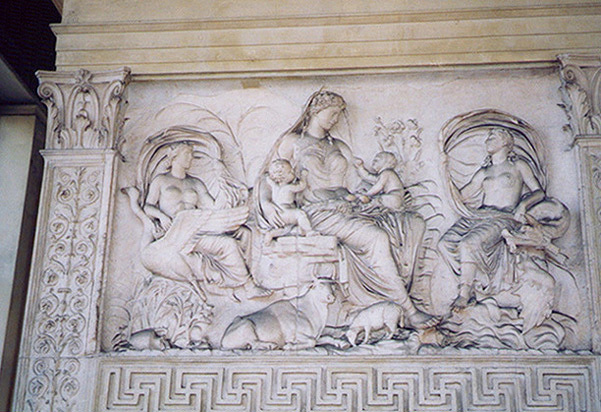The Pyramid of Gaius Cestius, 1995
Staircase in the Vatican Museum, Dec. 2003
Ceiling in the Sistine Chapel, Dec. 2003
Ceiling in the Sistine Chapel, Dec. 2003
Ceiling in the Sistine Chapel, Dec. 2003
Ceiling in the Sistine Chapel, Dec. 2003
Italian Couple Posing for Wedding Pictures in the…
The School of Athens Fresco by Raphael in the Vati…
Virgin and Child Stained Glass in the Vatican Muse…
The School of Athens Fresco by Raphael in the Vati…
Detail of the School of Athens Fresco by Raphael i…
Detail of the School of Athens Fresco by Raphael i…
The Battle of Ostia Fresco by Raphael in the Vatic…
Raphael Fresco: The Dispute Over the Sacrament in…
Portrait of Pope Julius II by Raphael in the Vatic…
Constantine on Horseback in the Vatican Museum, De…
Constantine on Horseback in the Vatican Museum, De…
From the Room of Constantine in the Vatican Museum…
The Crowning of Charlemagne by Raphael in the Vati…
View of the Beach from the Acropolis of Selinunte,…
On the Acropolis of Selinunte, 2005
Remains of Punic Houses on the Acropolis of Selinu…
The Remains of Temple C on the Acropolis of Selinu…
The Ara Pacis in Rome, June 1995
The Ceiling of the Sistine Chapel, 1995
Michelangelo's Last Judgment in the Sistine Chapel…
View through the Window from the Vatican Museum, 1…
The Apollo Belvedere, 1995
The Apollo Belvedere, 1995
River God in the Belvedere Courtyard, 1995
Laocoon in the Belvedere Courtyard, 1995
Laocoon in the Belvedere Courtyard in the Vatican…
Apotheosis of Antoninus and Faustina from the Base…
The Mustering of the Cavalry from the Base of the…
Perseus by Antonio Canova in the Belvedere Courtya…
The Vatican Library, 1995
The Spinario, 1995
The Capitoline Wolf, 1995
Medusa by Bernini in the Capitoline Museum, 1995
The Dying Gaul in the Capitoline Museum, June 1995
Foot of Constantine, 1995
Hand of Constantine, 1995
Colossal Head of Constantine, 1995
Wounded Amazon Statue in the Capitoline Museum, 20…
Statue of a Warrior in the Capitoline Museum, 2003
Keywords
Authorizations, license
-
Visible by: Everyone -
All rights reserved
-
476 visits
The Tellus Relief on the Ara Pacis in Rome, June 1995


The Ara Pacis Augustae (Latin, "Altar of Majestic Peace"; commonly shortened to Ara Pacis) is an altar to Peace, envisioned as a Roman goddess. It was commissioned by (or for) the Roman emperor Augustus, consecrated on 4 July 13 BC by the Senate to celebrate the peace established in the Empire after Augustus's victories in Gaul and Hispania. It was dedicated on 30 January 9 BC. The altar was meant to be a vision of the Roman civil religion. It sought to portray the peace and prosperity enjoyed as a result of the Pax Romana (Latin, "Roman peace") brought about by the military supremacy of the Roman empire.
The Ara Pacis was elaborately and finely sculpted entirely in gleaming white marble, depicting scenes of traditional Roman piety, in which the Emperor and his family were portrayed in the act of offering sacrifices to the gods. Various figures bring forth cattle to be sacrificed. Some have their togas drawn over their heads, like a hood; this signifies that they are acting in their official capacity as priests. Others wear laurel crowns, traditional symbols of victory. Men, women, and children all approach the gods. The Altar is considered a masterpiece of Roman sculpture; the figures in the procession are not idealised types, as are typically found in Greek sculpture, but rather recognizable portraits of individuals.
As it stands today, the Ara is a combination of original fragments found on the original site and kept in Rome, and of plaster casts of original fragments now in foreign museums, including the Louvre in Paris.
Text from: en.wikipedia.org/wiki/Ara_Pacis
The Ara Pacis was elaborately and finely sculpted entirely in gleaming white marble, depicting scenes of traditional Roman piety, in which the Emperor and his family were portrayed in the act of offering sacrifices to the gods. Various figures bring forth cattle to be sacrificed. Some have their togas drawn over their heads, like a hood; this signifies that they are acting in their official capacity as priests. Others wear laurel crowns, traditional symbols of victory. Men, women, and children all approach the gods. The Altar is considered a masterpiece of Roman sculpture; the figures in the procession are not idealised types, as are typically found in Greek sculpture, but rather recognizable portraits of individuals.
As it stands today, the Ara is a combination of original fragments found on the original site and kept in Rome, and of plaster casts of original fragments now in foreign museums, including the Louvre in Paris.
Text from: en.wikipedia.org/wiki/Ara_Pacis
- Keyboard shortcuts:
Jump to top
RSS feed- Latest comments - Subscribe to the comment feeds of this photo
- ipernity © 2007-2024
- Help & Contact
|
Club news
|
About ipernity
|
History |
ipernity Club & Prices |
Guide of good conduct
Donate | Group guidelines | Privacy policy | Terms of use | Statutes | In memoria -
Facebook
Twitter

Sign-in to write a comment.